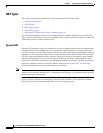
6-9
Cisco ASA Series Firewall ASDM Configuration Guide
Chapter 6 Configuring NAT (ASA 8.2 and Earlier)
NAT Overview
Static NAT
Static NAT creates a fixed translation of real address(es) to mapped address(es).With dynamic NAT and
PAT, each host uses a different address or port for each subsequent translation. Because the mapped
address is the same for each consecutive connection with static NAT, and a persistent translation rule
exists, static NAT allows hosts on the destination network to initiate traffic to a translated host (if an ACL
exists that allows it).
The main difference between dynamic NAT and a range of addresses for static NAT is that static NAT
allows a remote host to initiate a connection to a translated host (if an ACL exists that allows it), while
dynamic NAT does not. You also need an equal number of mapped addresses as real addresses with
static NAT.
Static PAT
Static PAT is the same as static NAT, except that it lets you specify the protocol (TCP or UDP) and port
for the real and mapped addresses.
This feature lets you identify the same mapped address across many different static statements, provided
the port is different for each statement. You cannot use the same mapped address for multiple static NAT
statements.
For applications that require inspection for secondary channels (for example, FTP and VoIP), the ASA
automatically translates the secondary ports.


















